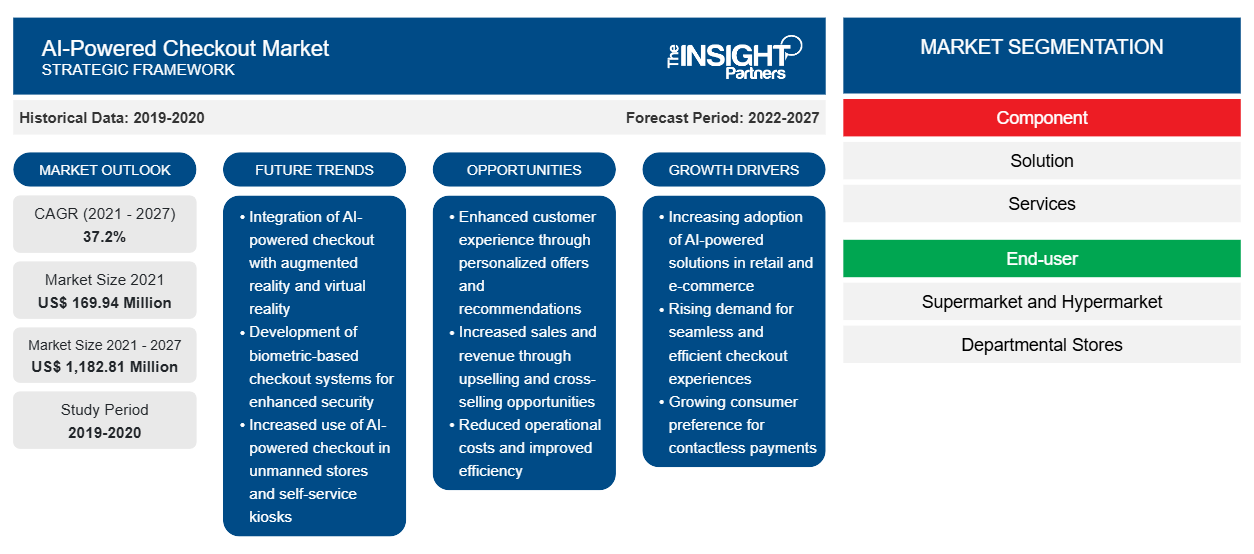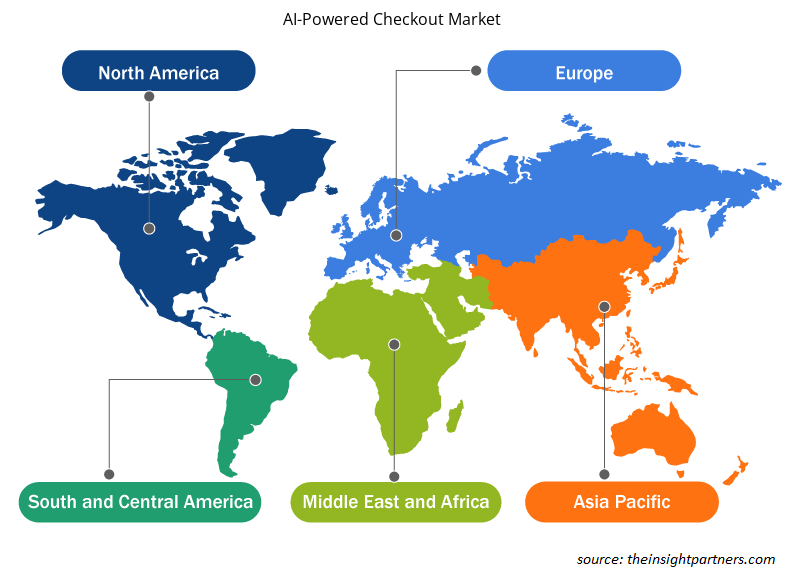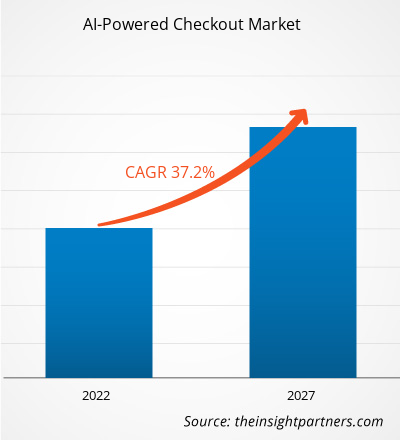The AI-powered checkout market was valued US$ 169.94 million in 2021 and it is expected to grow at a CAGR of 37.2% during the forecast period of 2021 to 2027.
AI-powered checkout provides various benefits such as quickly and easily installed, reducing the queue line in the shops, reducing labor costs, improving the customer experience, and improving profit margins. They are thereby increasing acceptance of AI-powered checkout, which triggers the growth of the AI-powered checkout market. Further, growing digitalization in the retail stores, coupled with the increase in the number of retail stores, supermarkets, and hypermarkets across the globe, provides a lucrative opportunity for the AI-powered checkout market player.
The pandemic COVID-19 continues to enforce the temporary closure of retail stores in the global market, signaling an unprecedented disruption of commerce. Retailers and brands are facing various short-term challenges regarding health and safety, supply chain, labor force, cash flow, consumer demand, and marketing. In North America, stores started closing at the beginning of March, and this trend is expected to continue as cities and states battle to contain the spread of the virus.
The market for AI-powered checkout has been segmented based on component, end-user, and geography. Based on component, the market is segmented into solution and services. The solution segment represented the largest share of the overall market throughout the forecast period, owing to the increasing number of technology advancements in machine vision, facial recognition, shelf sensors, barcodes, quick response (QR) codes, and RFID tags. However, services segment is expected to be the fastest-growing AI-powered checkout component. Further, the AI-powered checkout market is segmented into the supermarket and hypermarket, departmental stores, and others based on the end-user. In 2019, supermarket and hypermarket held a substantial share in the global AI-powered checkout market. While others segment is anticipated to grow at the highest CAGR from 2020 to 2027.
Customize This Report To Suit Your Requirement
You will get customization on any report - free of charge - including parts of this report, or country-level analysis, Excel Data pack, as well as avail great offers and discounts for start-ups & universities
AI-Powered Checkout Market: Strategic Insights

- Get Top Key Market Trends of this report.This FREE sample will include data analysis, ranging from market trends to estimates and forecasts.
You will get customization on any report - free of charge - including parts of this report, or country-level analysis, Excel Data pack, as well as avail great offers and discounts for start-ups & universities
AI-Powered Checkout Market: Strategic Insights

- Get Top Key Market Trends of this report.This FREE sample will include data analysis, ranging from market trends to estimates and forecasts.
AI-Powered Checkout Market Insights
Increase in Adoption of New Technologies in Retail Sector
The rising impact of e-commerce and continuous changes in consumer preferences are among the primary reasons that have led to stagnancy in the performance of the traditional retail sector. A few of the e-commerce market players are vigorously expanding their offline business operations to secure a share larger than the existing market share. Considering this, retailers operating worldwide are also continually looking forward to adopting more effective strategies to drive their revenue growth. Before the introduction of automation in the retail sector, retailers faced tremendous pressure to surpass customer expectations and enhance organizational efficiencies. The AI-powered checkouts provide the ability to overcome all the challenges faced by them, further helping them automate their workflows and multiple processes that ease their operations.
Component -Based Market Insights
Based on component, the AI-powered checkout market is segmented into solution and services. AI-powered checkout solution is provided to different retail outlets. This help the retailers to deliver greater shopping experience to the customers by eliminating need to standing in long-queues for making payments of the items purchased. Moreover, this software is provided with an array of services which assist the retailers to solve their grievances whenever they need.
End User -Based Market Insights
Based on end user, the AI-powered checkout market is segmented into departmental store, supermarket and hypermarket, and others. The AI-powered checkout solution is gaining high momentum across different retail outlets to eliminate a need to stand in long-queues for making payments. With the rising number of retail outlets, the scope of integrating advanced and autonomous technologies in them is increasing.
Players operating in the AI-powered checkout market focus on strategies, such as market initiatives, acquisitions, and product launches, to maintain their positions in the AI-powered checkout market. A few developments by key players of the AI-powered checkout market are:
In July 2020, AiFi announced plans to deploy 330 new and retrofitted autonomous stores by the end of 2021.
In January 2020, Focal Systems announced a partnership with Connors Group to provide impactful results to retailers by combining the technologies of both the companies.
AI-Powered Checkout Market Regional Insights
The regional trends and factors influencing the AI-Powered Checkout Market throughout the forecast period have been thoroughly explained by the analysts at The Insight Partners. This section also discusses AI-Powered Checkout Market segments and geography across North America, Europe, Asia Pacific, Middle East and Africa, and South and Central America.

- Get the Regional Specific Data for AI-Powered Checkout Market
AI-Powered Checkout Market Report Scope
| Report Attribute | Details |
|---|---|
| Market size in 2021 | US$ 169.94 Million |
| Market Size by 2027 | US$ 1,182.81 Million |
| Global CAGR (2021 - 2027) | 37.2% |
| Historical Data | 2019-2020 |
| Forecast period | 2022-2027 |
| Segments Covered |
By Component
|
| Regions and Countries Covered | North America
|
| Market leaders and key company profiles |
AI-Powered Checkout Market Players Density: Understanding Its Impact on Business Dynamics
The AI-Powered Checkout Market is growing rapidly, driven by increasing end-user demand due to factors such as evolving consumer preferences, technological advancements, and greater awareness of the product's benefits. As demand rises, businesses are expanding their offerings, innovating to meet consumer needs, and capitalizing on emerging trends, which further fuels market growth.
Market players density refers to the distribution of firms or companies operating within a particular market or industry. It indicates how many competitors (market players) are present in a given market space relative to its size or total market value.
Major Companies operating in the AI-Powered Checkout Market are:
- Mashgin, Inc.
- AiFi Inc.
- FOCAL SYSTEMS INC.
- Accel Robotics Corporation
- Toshiba Corporation
Disclaimer: The companies listed above are not ranked in any particular order.

- Get the AI-Powered Checkout Market top key players overview
AI-Powered Checkout Market – by Component
- Solution
- Services
AI-Powered Checkout Market – by End-User
- Supermarket and Hypermarket
- Departmental Stores
- Others
AI-Powered Checkout Market – by Geography
North America
- US
- Canada
- Mexico
Europe
- France
- Germany
- Spain
- UK
- Russia
- Rest of Europe
Asia Pacific (APAC)
- China
- India
- Japan
- Australia
- South Korea
- Rest of APAC
MEA
- Saudi Arabia
- UAE
- South Africa
- Rest of MEA
SAM
- Brazil
- Rest of SAM
AI-Powered Checkout Market – Company Profiles
- Accel Robotics Corporation
- AiFi Inc.
- FOCAL SYSTEMS INC.
- Fujitsu Limited
- Mashgin, Inc.
- NCR Corporation
- Standard Cognition
- Toshiba Corporation
- Trigo
- Zippin
- Historical Analysis (2 Years), Base Year, Forecast (7 Years) with CAGR
- PEST and SWOT Analysis
- Market Size Value / Volume - Global, Regional, Country
- Industry and Competitive Landscape
- Excel Dataset
- Parking Meter Apps Market
- eSIM Market
- Advanced Distributed Management System Market
- Online Exam Proctoring Market
- Electronic Data Interchange Market
- Barcode Software Market
- Maritime Analytics Market
- Cloud Manufacturing Execution System (MES) Market
- Robotic Process Automation Market
- Digital Signature Market
Testimonials
Reason to Buy
- Informed Decision-Making
- Understanding Market Dynamics
- Competitive Analysis
- Identifying Emerging Markets
- Customer Insights
- Market Forecasts
- Risk Mitigation
- Boosting Operational Efficiency
- Strategic Planning
- Investment Justification
- Tracking Industry Innovations
- Aligning with Regulatory Trends
Yes! We provide a free sample of the report, which includes Report Scope (Table of Contents), report structure, and selected insights to help you assess the value of the full report. Please click on the "Download Sample" button or contact us to receive your copy.
Absolutely — analyst assistance is part of the package. You can connect with our analyst post-purchase to clarify report insights, methodology or discuss how the findings apply to your business needs.
Once your order is successfully placed, you will receive a confirmation email along with your invoice.
• For published reports: You’ll receive access to the report within 4–6 working hours via a secured email sent to your email.
• For upcoming reports: Your order will be recorded as a pre-booking. Our team will share the estimated release date and keep you informed of any updates. As soon as the report is published, it will be delivered to your registered email.
We offer customization options to align the report with your specific objectives. Whether you need deeper insights into a particular region, industry segment, competitor analysis, or data cut, our research team can tailor the report accordingly. Please share your requirements with us, and we’ll be happy to provide a customized proposal or scope.
The report is available in either PDF format or as an Excel dataset, depending on the license you choose.
The PDF version provides the full analysis and visuals in a ready-to-read format. The Excel dataset includes all underlying data tables for easy manipulation and further analysis.
Please review the license options at checkout or contact us to confirm which formats are included with your purchase.
Our payment process is fully secure and PCI-DSS compliant.
We use trusted and encrypted payment gateways to ensure that all transactions are protected with industry-standard SSL encryption. Your payment details are never stored on our servers and are handled securely by certified third-party processors.
You can make your purchase with confidence, knowing your personal and financial information is safe with us.
Yes, we do offer special pricing for bulk purchases.
If you're interested in purchasing multiple reports, we’re happy to provide a customized bundle offer or volume-based discount tailored to your needs. Please contact our sales team with the list of reports you’re considering, and we’ll share a personalized quote.
Yes, absolutely.
Our team is available to help you make an informed decision. Whether you have questions about the report’s scope, methodology, customization options, or which license suits you best, we’re here to assist. Please reach out to us at sales@theinsightpartners.com, and one of our representatives will get in touch promptly.
Yes, a billing invoice will be automatically generated and sent to your registered email upon successful completion of your purchase.
If you need the invoice in a specific format or require additional details (such as company name, GST, or VAT information), feel free to contact us, and we’ll be happy to assist.
Yes, certainly.
If you encounter any difficulties accessing or receiving your report, our support team is ready to assist you. Simply reach out to us via email or live chat with your order information, and we’ll ensure the issue is resolved quickly so you can access your report without interruption.





















 Get Free Sample For
Get Free Sample For